Tidewrack has an image problem. Who wants to see a dark line of seaweed on a beach of white sand or to smell rotting beds of kelp in enclosed bays? Shorebird conservationists may understand the feeding opportunities that are provided by fresh and older seaweed but, for tourist boards, tidewrack is something that needs to be cleared away.
It turns out that tidewrack is not just a biodiverse habitat; the mere presence of seaweed creates spaces in which waders can roost and find shelter. In a paper in the Journal of Applied Ecology, Timothy Davis & Gunnar Keppel get down to Turnstone-level, to investigate the important microhabitats within different forms of beach-cast wrack.
An Australian autumn
Readers in the northern hemisphere may well have seen wintering waders sheltering in the lee of clumps of tidewrack, as a gale blows snow and sand across a beach. At Danger Point, about half-way between Melbourne and Adelaide on the coast of Australia, conditions are somewhat different, with December and January temperatures topping 30°C, conditions in which waders must try to avoid over-heating. By April, when the Davis & Keppel study was carried out, conditions were autumnal, with cool mornings. Three of the species that might be seen on a European beach were present – Turnstone, Sanderling and Bar-tailed Godwit – but with the addition of Curlew Sandpipers and Red-necked Stints, that were about to depart for Siberia, and Double-banded Plovers that breed in New Zealand.

What might waders be looking for?
The research team was interested in the range of microclimates available on beaches with beach-cast wrack, to investigate the link between microclimates and microhabitats and how they are used by waders. They expected to find warmer temperatures and higher humidity on aged wrack, due to advanced decomposition, and ameliorated conditions where wrack deposits provided shelter from prevailing winds. They predicted that waders would use microclimates that could reduce energy loss.
Observations
Data on temperature and humidity were collected by creating miniature Stevenson Screens – hollow white practice golf balls with iButtons inside them, attached to short bamboo canes, so as to be 10 cm above the substrate surface. If interested in conducting this sort of study, it would be sensible to read the methods section of the paper. Sample points were on bare sand, in areas with fresh wrack deposited on the sand and in beds of old tidewrack. Based on surrounding features and observations of prevailing winds, sample points were classified as sheltered or exposed.
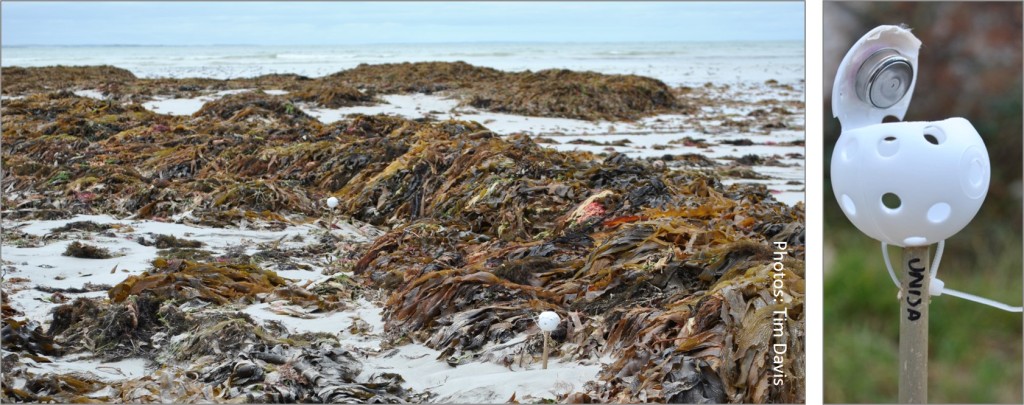
Instantaneous scan sampling was used to classify migratory shorebird behaviour for the entire Danger Point study area (i.e., the area over which the microsensors were placed) at 15 min intervals on four days during April, as birds were preparing to migrate. Birds were classified as roosting (loafing, sleeping or preening) or as foraging on one of the three substrate types.
Variability of microclimate
As expected, there were significant differences among the three substrates (sand, fresh wrack and aged wrack) for mean, maximum and minimum temperature and absolute humidity. The temperature above the surface of aged wrack was consistently higher than elsewhere, with one notable exception: in the early mornings, when newly deposited seaweed retained some of the heat from the warmer ocean, temperatures were warmer on fresh wrack than on sand and aged wrack. For aged wrack, humidity was highest above deeper beds.

Bird Behaviour
Six species of wader were studied and included in ‘all waders’ counts but there were insufficient sightings of Bar-tailed Godwit, Curlew Sandpiper, Ruddy Turnstone and Sanderling for separate analyses. The main focus was upon Red-necked Stint (64.0% of observations) and Double-banded Plover (31.4%).
- Roosting birds were recorded on aged wrack 16 times more frequently than sand, and three times more than on fresh wrack.
- Foraging birds were observed more than four times as often on aged wrack, when compared to fresh wrack or sand.
- However, roosting on fresh wrack was more frequent in cooler, early-morning temperatures, for all waders and for the Double-banded Plover, when considered separately. Neither temperature nor absolute humidity were significant predictors of the proportion of Red-necked Stints roosting in areas with fresh wrack.
- Foraging by waders (in general) and Double-banded Plover (in particular) was also more common within fresh deposits of wrack when temperatures were low and particularly if humidity was high. For Red-necked Stint, temperature alone predicted whether they were more likely to feed on fresh wrack, rather than aged wrack.
The importance of microhabitats
The authors show that sandy beaches with beach-cast wrack provide a complex mosaic of microclimates/habitats across differing substrates. Birds seem to exploit the microclimatic variation by using microhabitats that minimise energy expenditure, as both foraging and roosting were most likely to occur on the substrate providing the warmest, most energy-efficient conditions at the time.
There is well-documented evidence that food availability increases as seaweed decays, because wrack-beds provide homes for invertebrates, particularly developing larvae. This explains a predominance of foraging on aged wrack, which is likely to provide the best feeding opportunities. The key finding in this study is that tidewrack on sandy beaches provides important additional benefits for waders, by providing shelter and warmth. This may be particularly important when birds are fattening up for the next leg of a migratory journey. It is particularly interesting that, early in the morning, Double-banded Plovers and Red-necked Stints foraged within fresh wrack, the warmest available substrate at that time. Perhaps the effect of microclimate (temperature, humidity & shelter) might be usefully studied in other circumstances in which waders feed and roost?
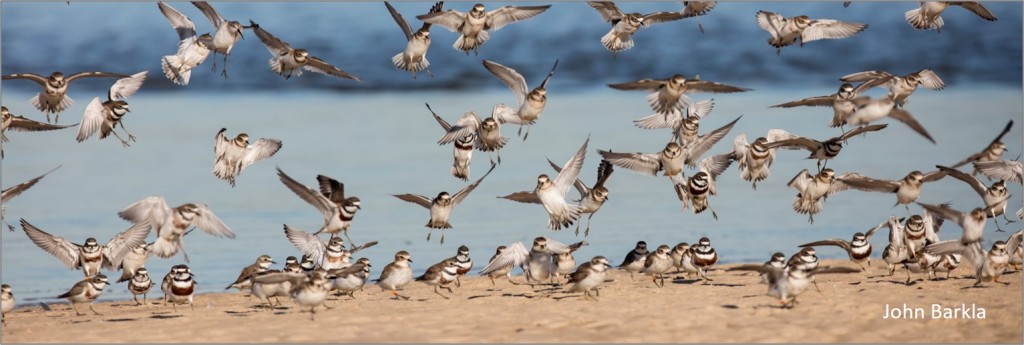
The bigger picture
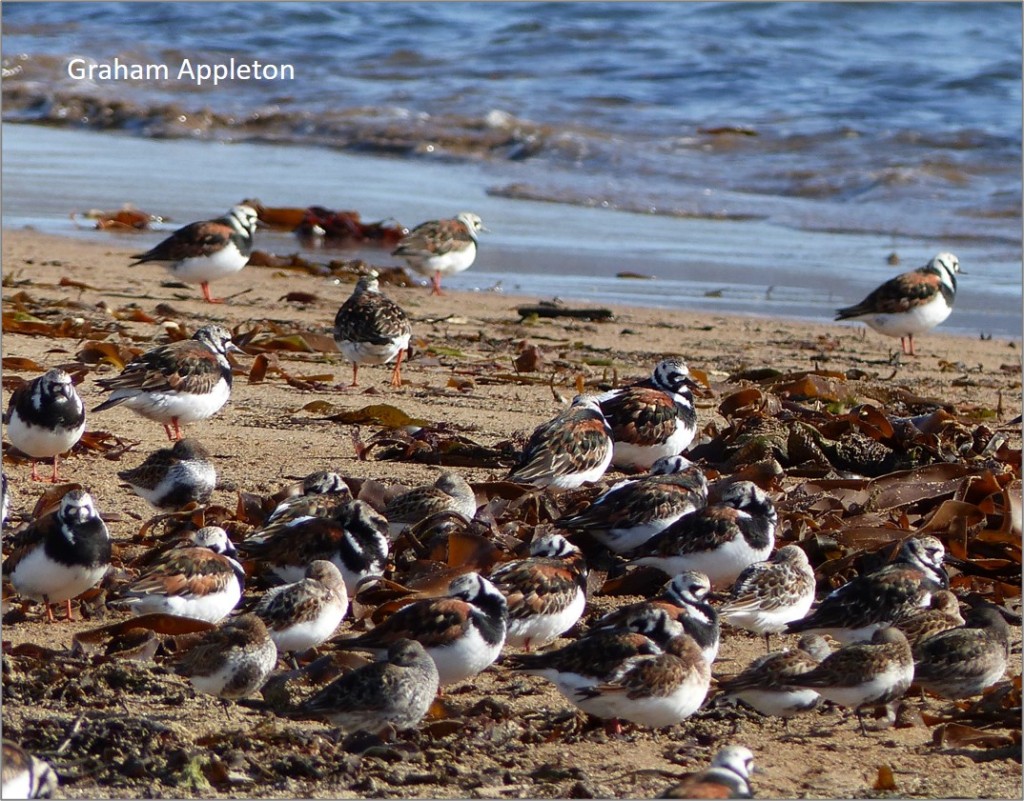
When considering the role that coastal ecosystems play in the lives of waders, the main conservation focus has been on estuaries, as for instance discussed in Wader declines in the shrinking Yellow Sea. The open coastline is under threat too, squeezed by rising sea levels, battered by more frequent storms, polluted by plastic etc. In some areas, waders that use these habitats outside the breeding season are also prone to human (and canine) disturbance, as described in this Turnstone study.
Alongside more general habitat degradation, there are specific threats to tidewrack habitats along the coastline. This starts offshore, with the harvesting of stands of growing kelp, and continues when fresh tide-wrack is collected or cleared from shorelines. In 2018, it is estimated that 15,000,000 tonnes of brown algae were removed, globally. Traditionally, rotted tidewrack has been used as a fertiliser on nearby fields but most of the current output is collected when fresh and used to produce alginates, for food manufacture and biomedical purposes. Increasingly, attention is turning to use in biofuels, which has the potential to greatly increase the demand for seaweed.
Whilst the food, biomedical and energy industries see value in tidewrack, the tourist industry appears to see it as an untidy nuisance that spoils the image of a pristine beach. Who knows how much tidewrack is removed from beaches during daily grooming sessions or dug out of wader-rich corners before the start of the tourist season? If the image of what constitutes a welcoming beach is to be changed then perhaps there needs to be a focus on the interest that seaweed adds to a tideline walk – as visitors collect shells and look for amber, sea-coal and egg-cases. Is this naïve; have cotton buds, bottles and plastic sullied the image of tidewrack? Should we share more photographs of Sanderling chasing through seaweed-flecked spume and flocks of waders ‘chilling’ on banks of beautifully lit seaweed, instead of the barren white beaches that are used in holiday adverts?
As Timothy Davis and Gunnar Keppel conclude: “Beach-cast wrack created a complex mosaic of unique microclimates varying in space and time, which seemingly allowed shorebirds to minimize energy expenditure, by selecting the thermally most favourable habitats for roosting and foraging. Removal of beach-cast wrack therefore reduces habitat quality and increases energy expenditure and resources in shorebirds and may contribute to the observed decline of migratory shorebird species globally. Management of coastal ecosystems and shorebirds therefore needs to maintain fine-scale environmental heterogeneity.”
Paper
Fine-scale environmental heterogeneity is important for conservation management: beach-cast wrack creates important microhabitats for thermoregulation in shorebirds. Timothy John Davis & Gunnar Keppel. Journal of Applied Ecology. April 2021

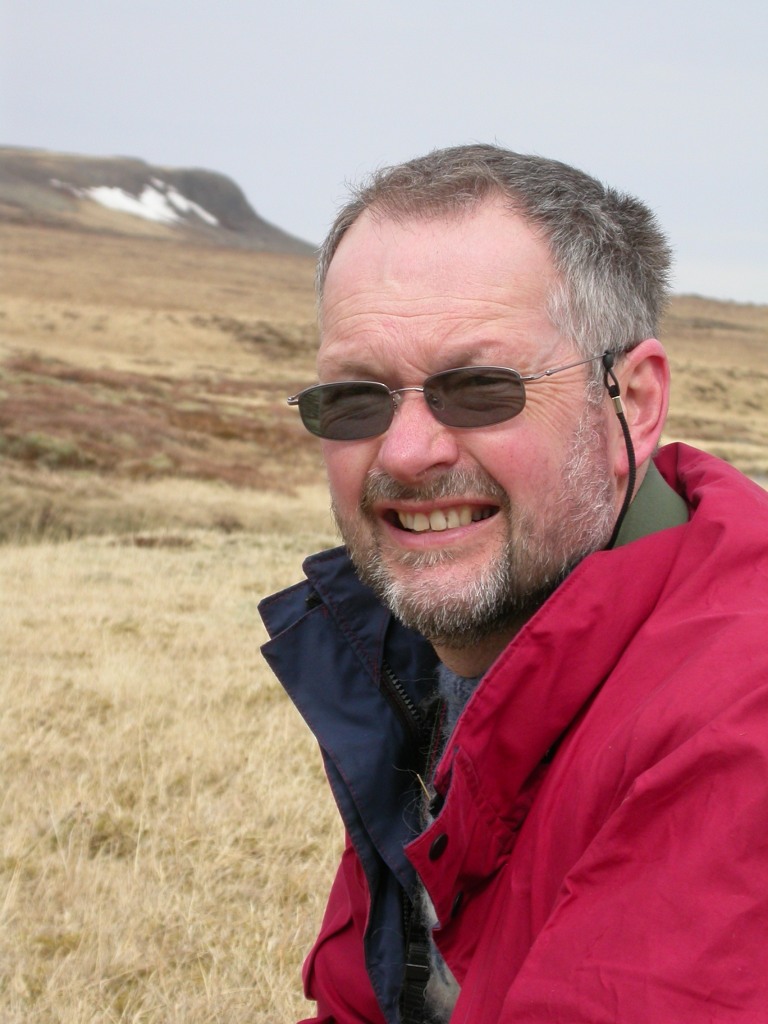
WaderTales blogs are written by Graham Appleton (@GrahamFAppleton) to celebrate waders and wader research. Many of the articles are based on published papers, with the aim of making shorebird science available to a broader audience.
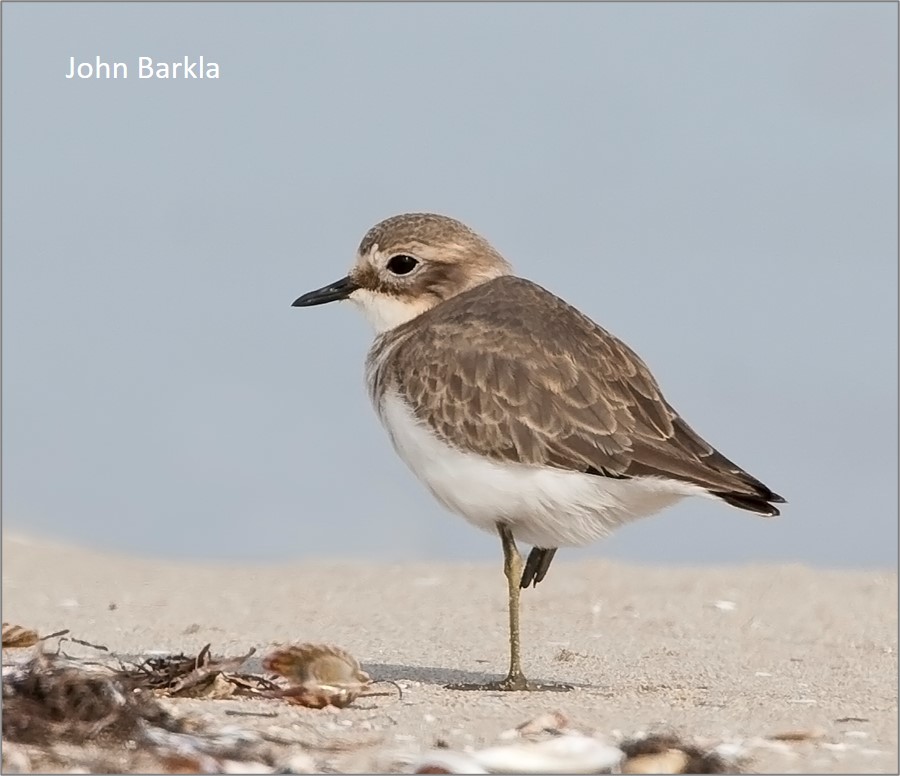
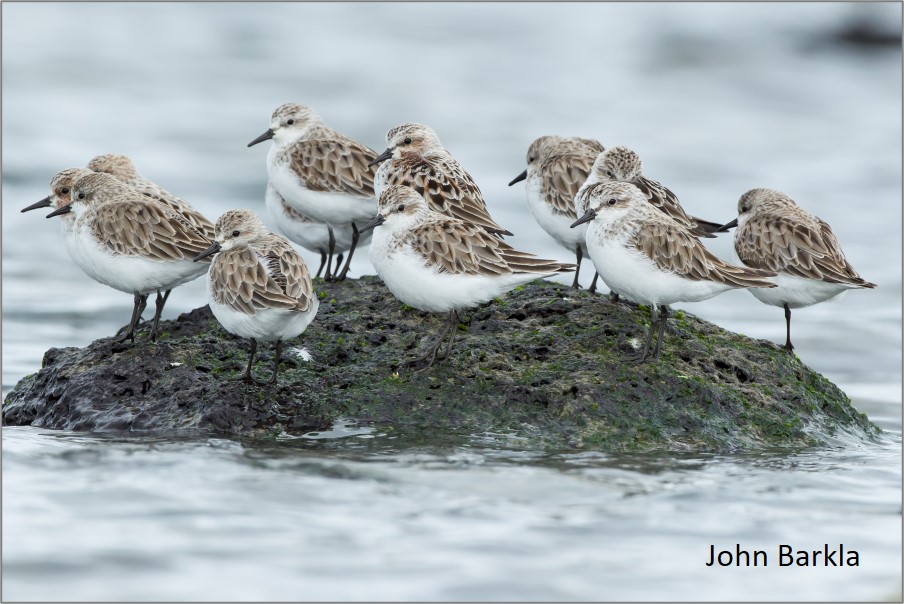
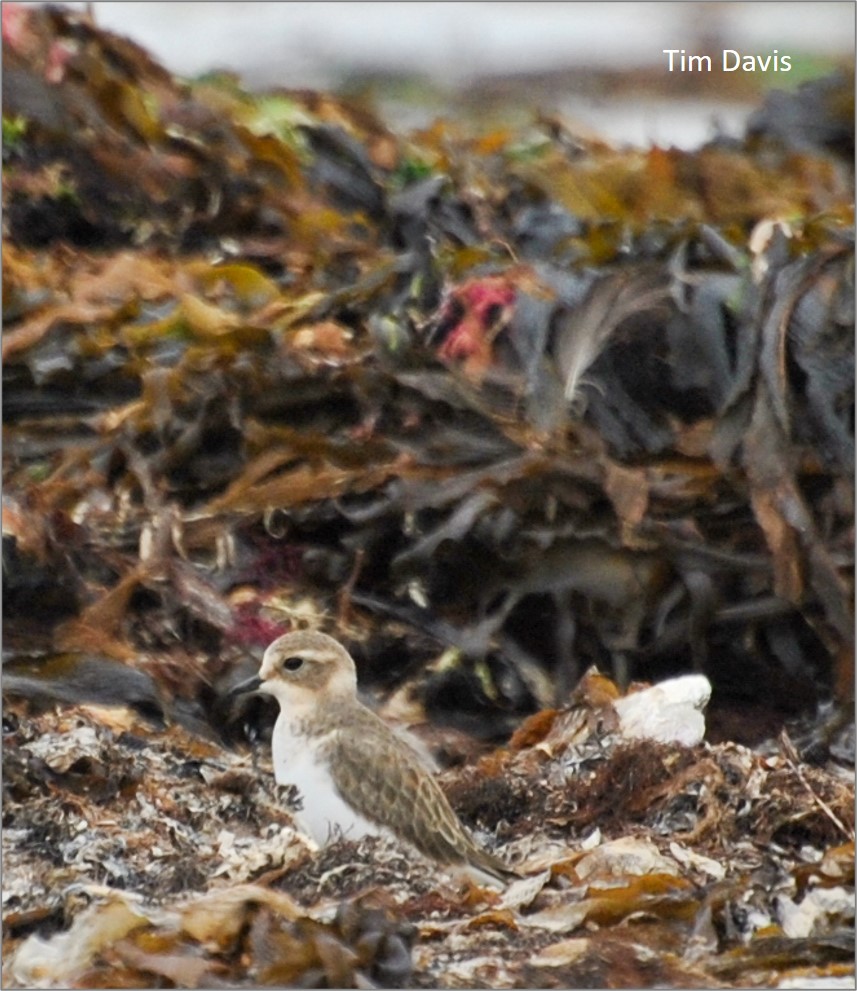
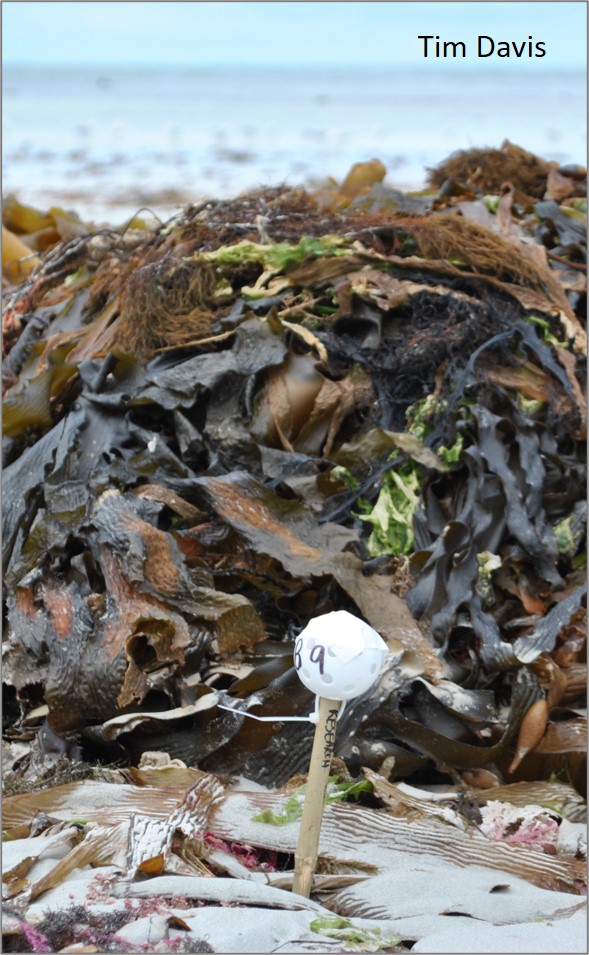
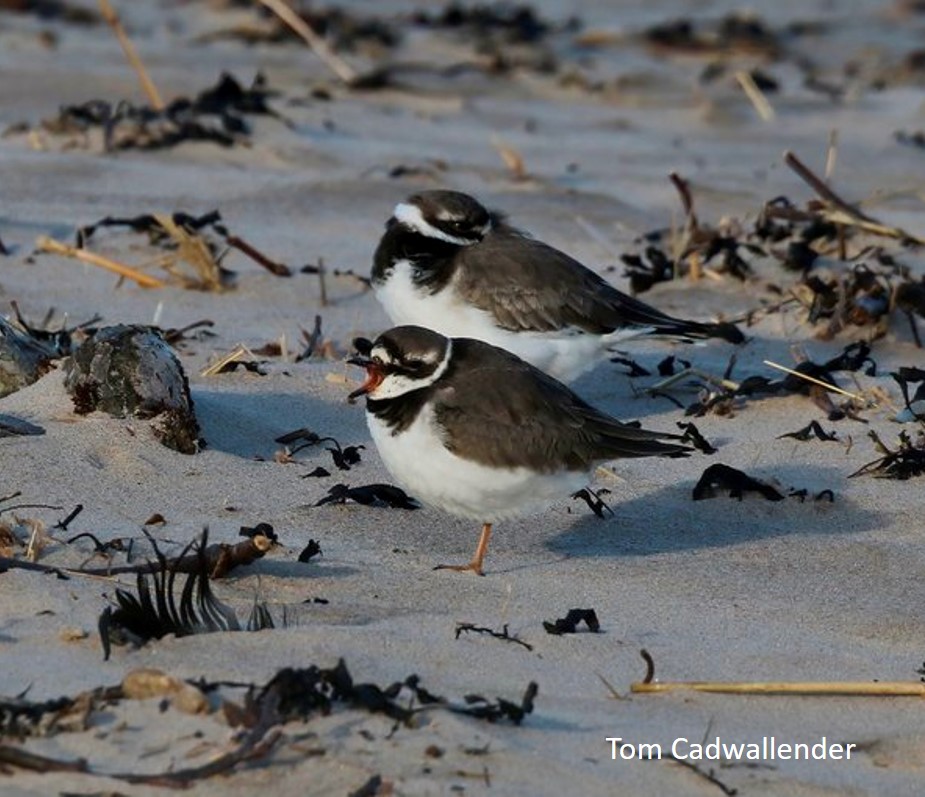
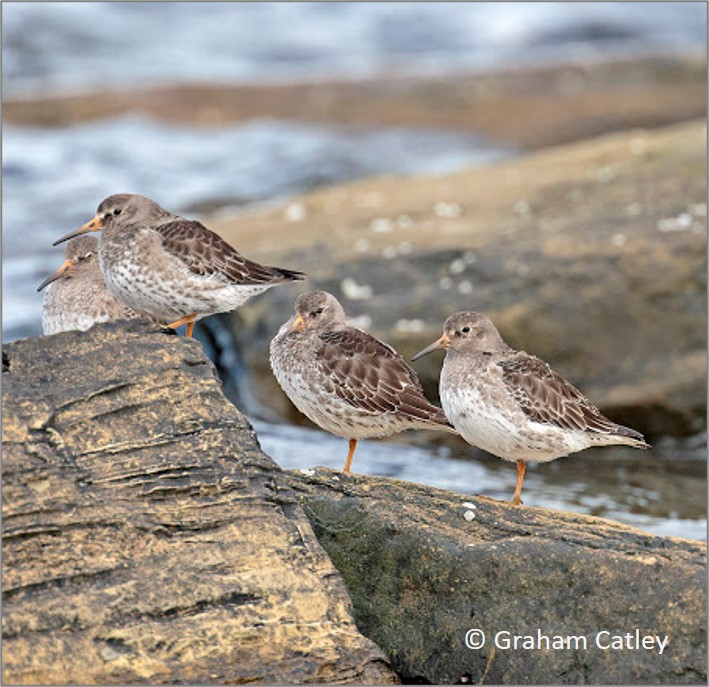
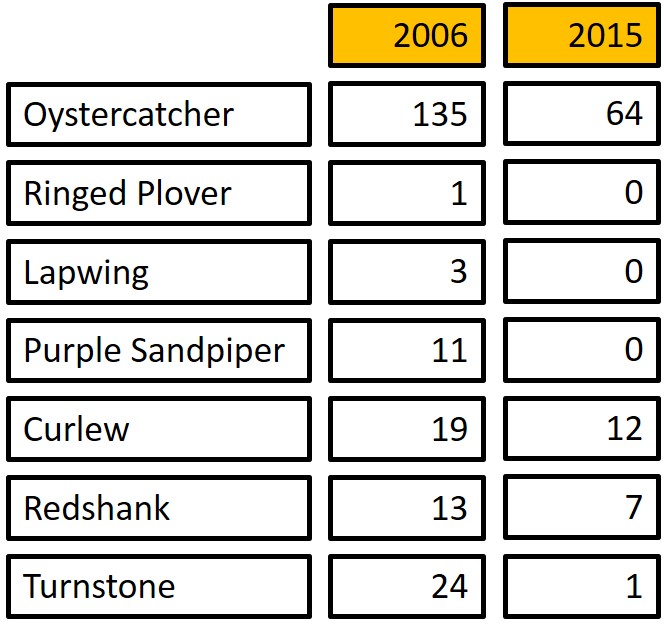
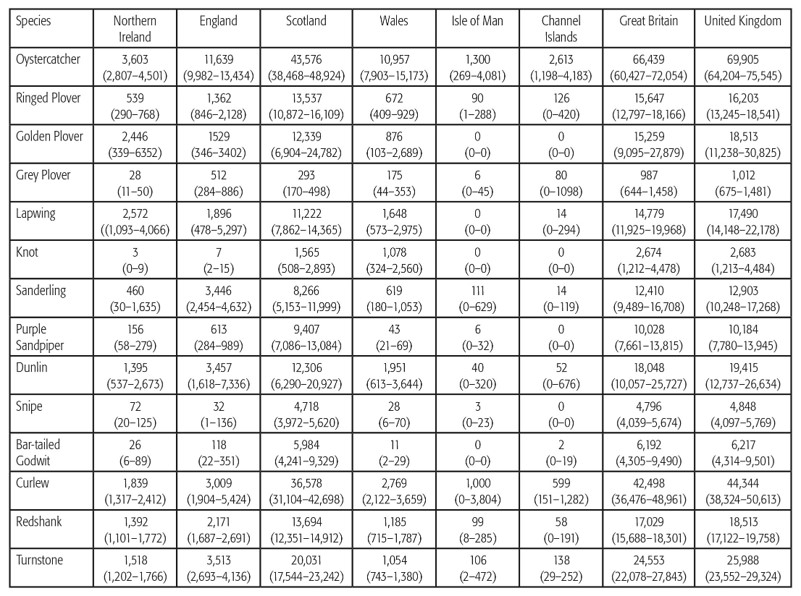
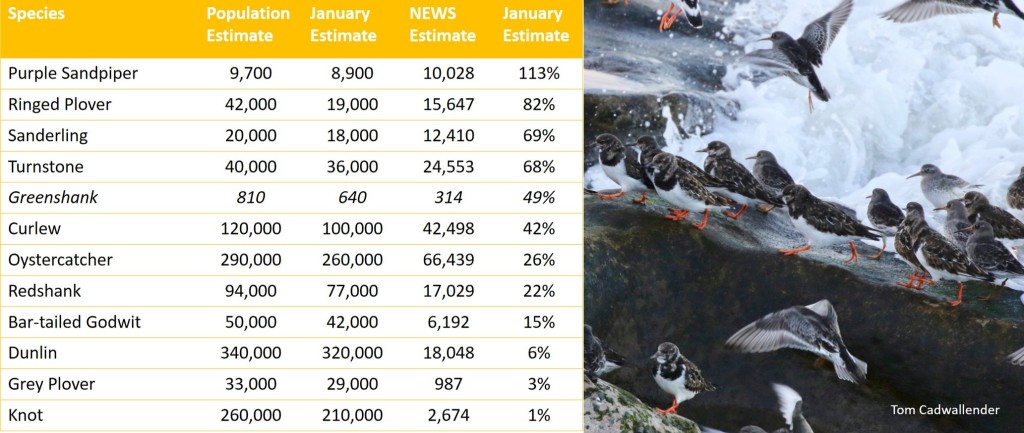
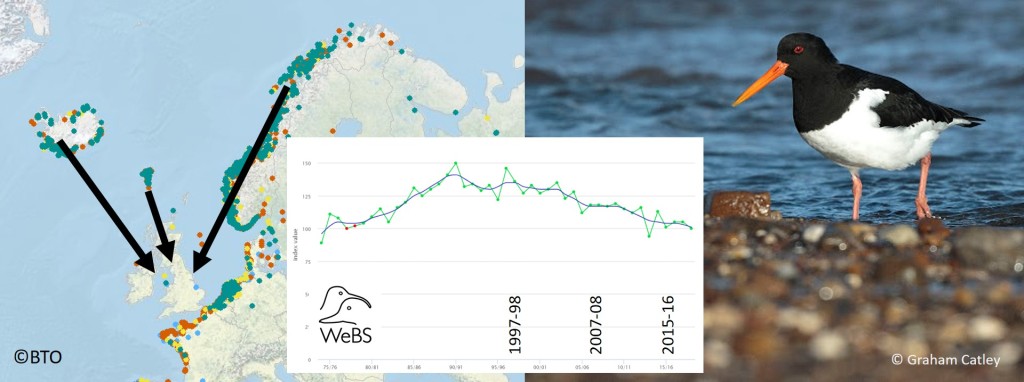

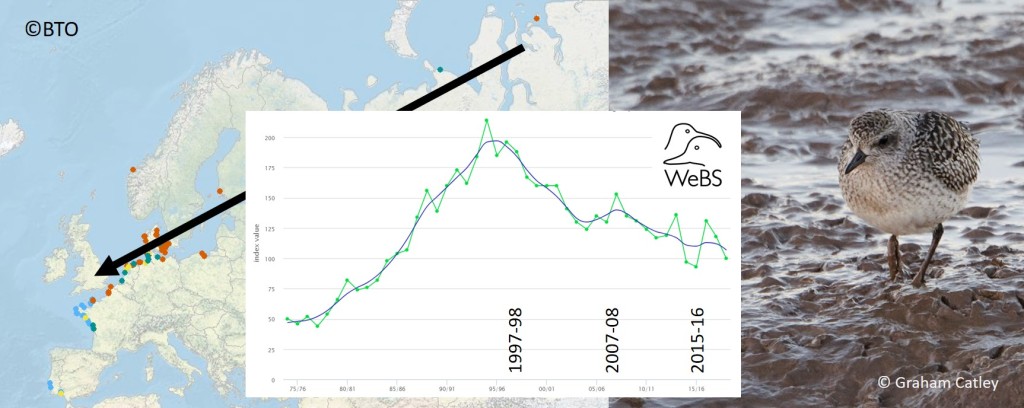

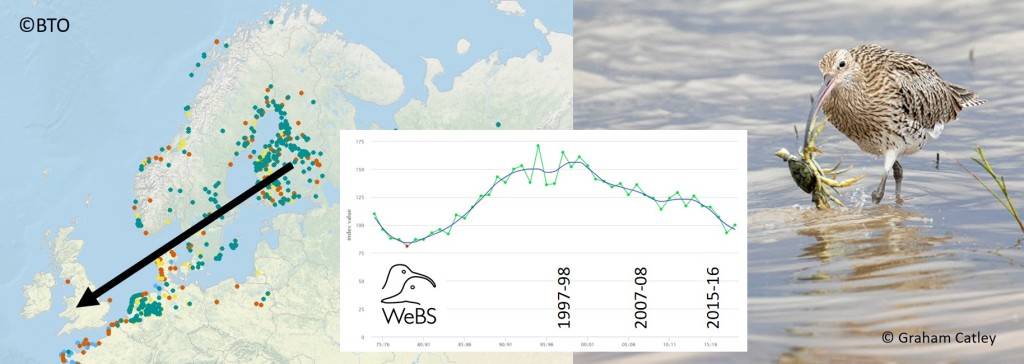
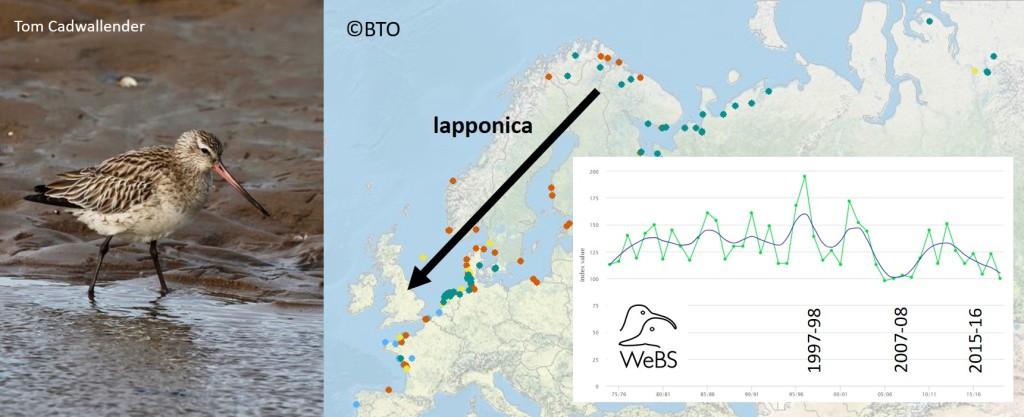
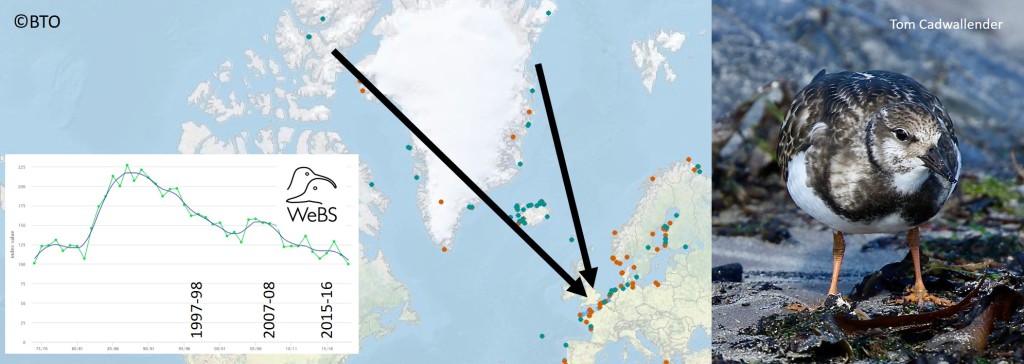
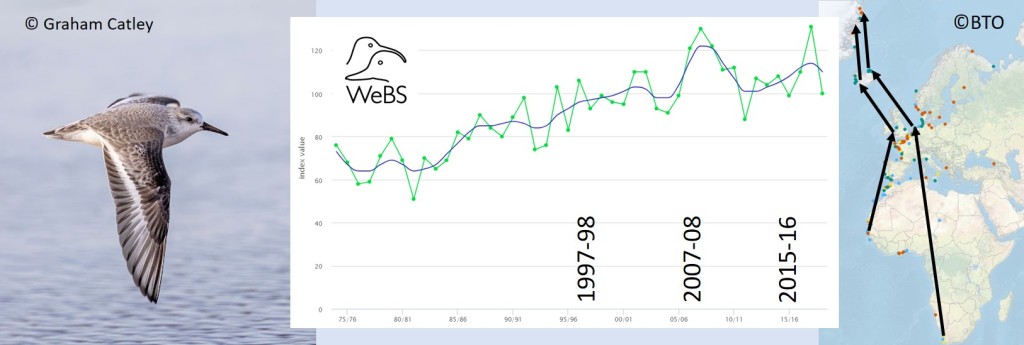
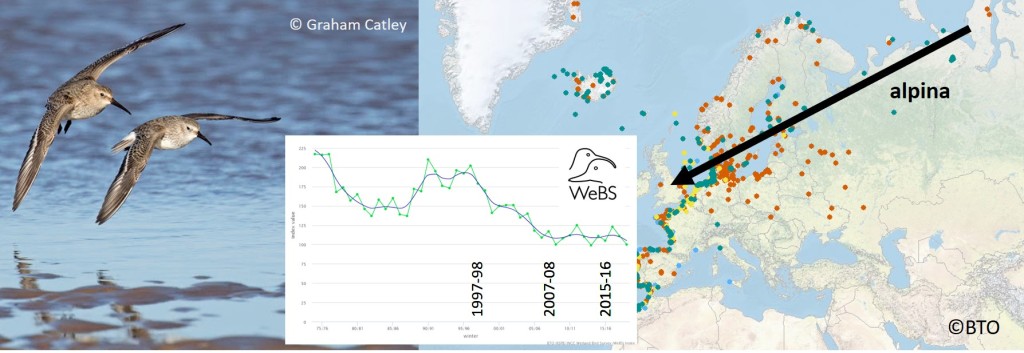
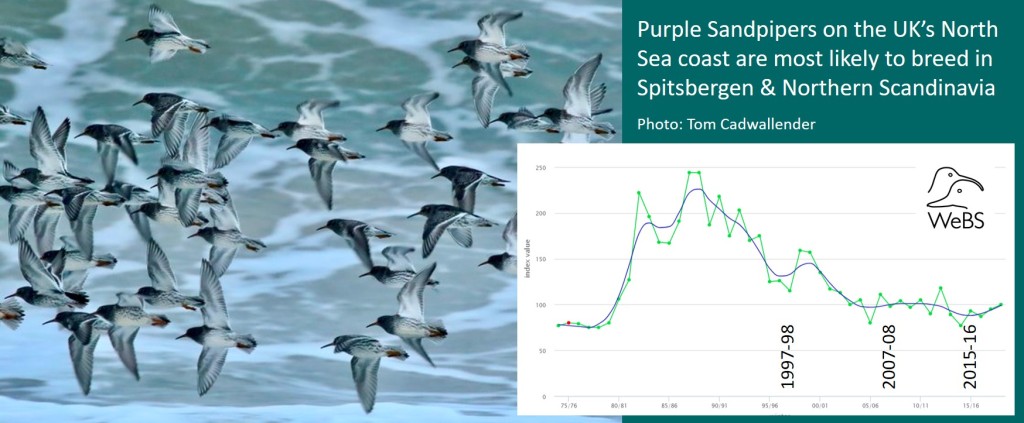
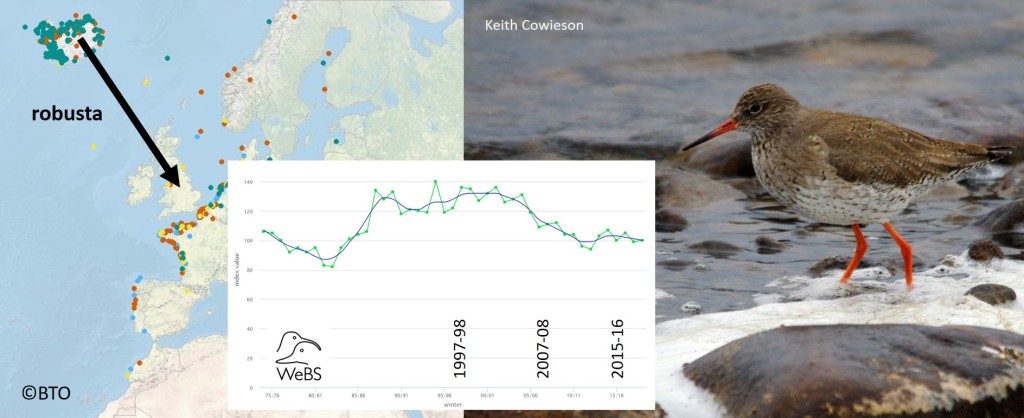
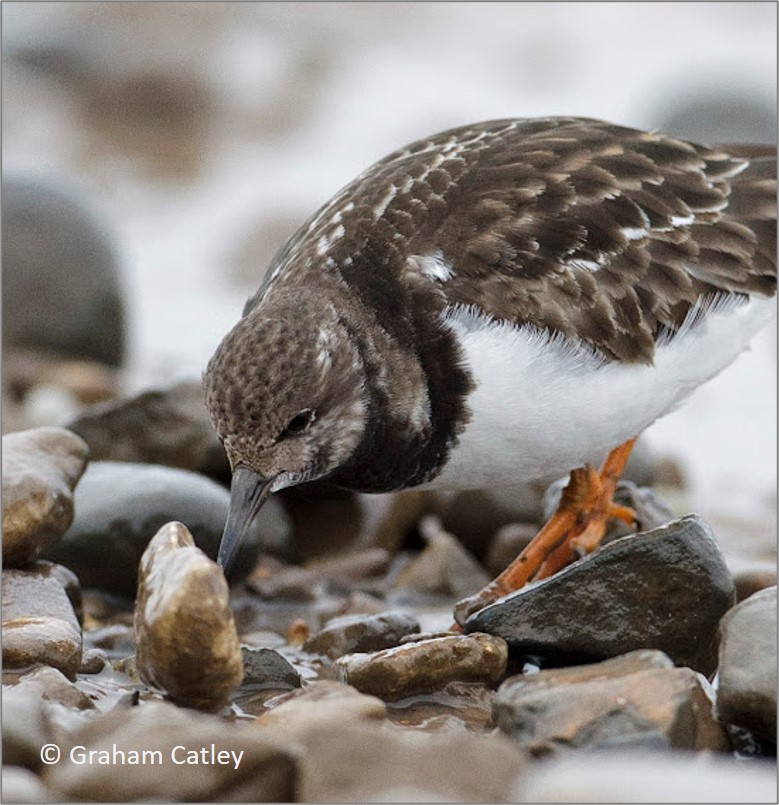
 In a 2020 paper, Mark Whittingham and colleagues show that, in one area of northeast England, the decline in Turnstone numbers is more obvious on mainland sites that are subject to human disturbance than on offshore refuges. Whilst national declines are probably linked to factors affecting productivity in breeding areas in Greenland and Canada, it is interesting that Turnstone seem to be withdrawing into areas where they are subject to less winter disturbance.
In a 2020 paper, Mark Whittingham and colleagues show that, in one area of northeast England, the decline in Turnstone numbers is more obvious on mainland sites that are subject to human disturbance than on offshore refuges. Whilst national declines are probably linked to factors affecting productivity in breeding areas in Greenland and Canada, it is interesting that Turnstone seem to be withdrawing into areas where they are subject to less winter disturbance. 



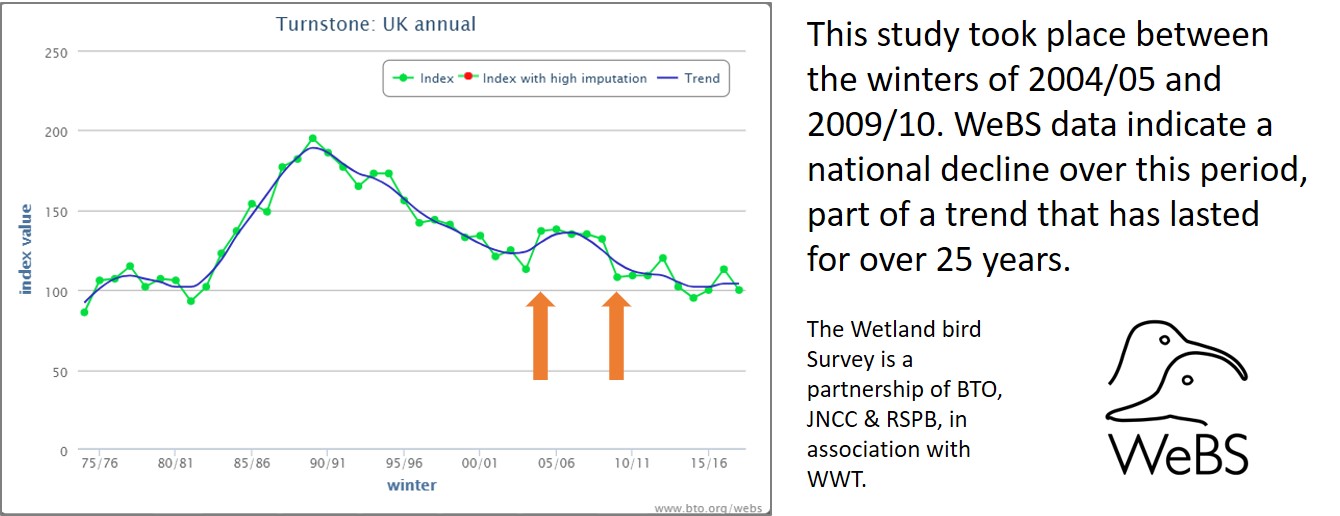





 Graham (
Graham ( In a fascinating comparison of weight gained by Red Knot and Ruddy Turnstone during spring migration in Delaware Bay, on America’s east-coast flyway, Anna Tucker and colleagues show that Knot are far more vulnerable to annual variations in their main food supply than more flexible Turnstones, which target the same food if it is available. Given that changing weather patterns, associated with a warming climate, are expected to make resource availability harder to predict, the authors suggest that populations of migrant shorebirds (waders) that rely on a specific resource being available at the right time are likely to be more vulnerable – as has become apparent for Delaware Bay Knot.
In a fascinating comparison of weight gained by Red Knot and Ruddy Turnstone during spring migration in Delaware Bay, on America’s east-coast flyway, Anna Tucker and colleagues show that Knot are far more vulnerable to annual variations in their main food supply than more flexible Turnstones, which target the same food if it is available. Given that changing weather patterns, associated with a warming climate, are expected to make resource availability harder to predict, the authors suggest that populations of migrant shorebirds (waders) that rely on a specific resource being available at the right time are likely to be more vulnerable – as has become apparent for Delaware Bay Knot.
 Northward migration of Knot and Turnstone begins in late April/early May, with most birds arriving in Delaware Bay in mid to late May and staying for between one and two weeks, before continuing north to begin breeding in early June. The optimal breeding window in the Arctic is short and punctual arrival on territory is important if waders are to have a productive nesting season. This means that spring fattening at migration sites can directly affect breeding success. Weight data for both species were collected between 1 May and 5 June over a twenty-two-year period between 1997 and 2018, with horseshoe crab counts being made since 2003. Birds were marked with flags, with resightings in the same year providing an indication of length of stay. Recaptures of marked birds provided information on weight gain, while sightings in subsequent years gave estimates of apparent survival.
Northward migration of Knot and Turnstone begins in late April/early May, with most birds arriving in Delaware Bay in mid to late May and staying for between one and two weeks, before continuing north to begin breeding in early June. The optimal breeding window in the Arctic is short and punctual arrival on territory is important if waders are to have a productive nesting season. This means that spring fattening at migration sites can directly affect breeding success. Weight data for both species were collected between 1 May and 5 June over a twenty-two-year period between 1997 and 2018, with horseshoe crab counts being made since 2003. Birds were marked with flags, with resightings in the same year providing an indication of length of stay. Recaptures of marked birds provided information on weight gain, while sightings in subsequent years gave estimates of apparent survival. Masses of most of the Knot and Turnstone caught in Delaware Bay were within the published range for the two species (Knot 125–205 g and Turnstone 84–190 g) with individually-marked Knot doubling their weight during their stay.
Masses of most of the Knot and Turnstone caught in Delaware Bay were within the published range for the two species (Knot 125–205 g and Turnstone 84–190 g) with individually-marked Knot doubling their weight during their stay.
 Aerial counts of Knot and other shorebirds have been taking place in Delaware Bay since 1981. Over this period Knot counts have varied but the big peaks of nearly 100,000 of the 1980s are now replaced by peaks that rarely exceed 25,000. See table taken from totals reported in USF&WS Rufa Red Knot background information and threats assessment. The declines in the Delaware spring passage numbers are similar in size to the drop in numbers seen wintering in Tierra del Fuego (far south of Argentina).
Aerial counts of Knot and other shorebirds have been taking place in Delaware Bay since 1981. Over this period Knot counts have varied but the big peaks of nearly 100,000 of the 1980s are now replaced by peaks that rarely exceed 25,000. See table taken from totals reported in USF&WS Rufa Red Knot background information and threats assessment. The declines in the Delaware spring passage numbers are similar in size to the drop in numbers seen wintering in Tierra del Fuego (far south of Argentina).

 Long‐distance migrants rely on predictable resources at stopover sites; even when these linkages are simple and predictable, populations can be vulnerable to change. The Tucker paper suggests that generalist foraging strategies, as used by Turnstone, may dampen the negative effects of phenological mismatch.
Long‐distance migrants rely on predictable resources at stopover sites; even when these linkages are simple and predictable, populations can be vulnerable to change. The Tucker paper suggests that generalist foraging strategies, as used by Turnstone, may dampen the negative effects of phenological mismatch.

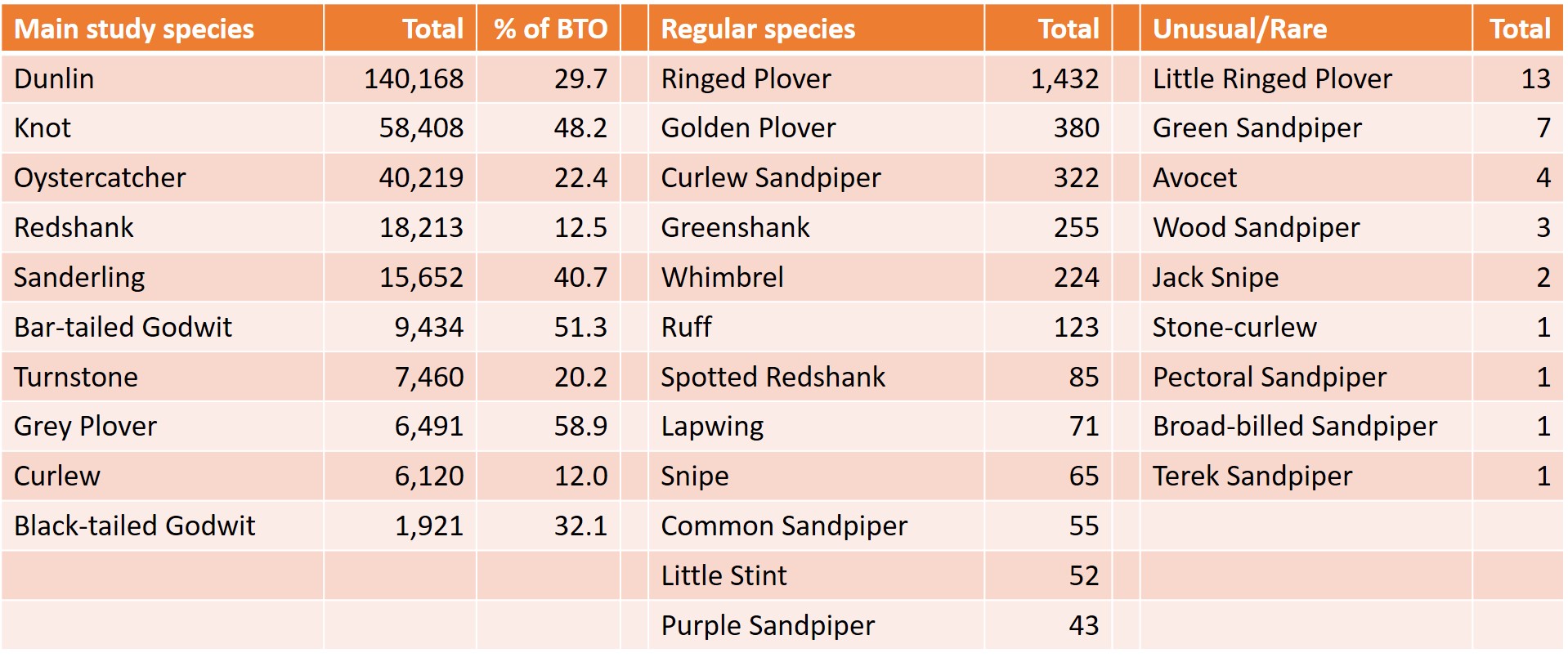
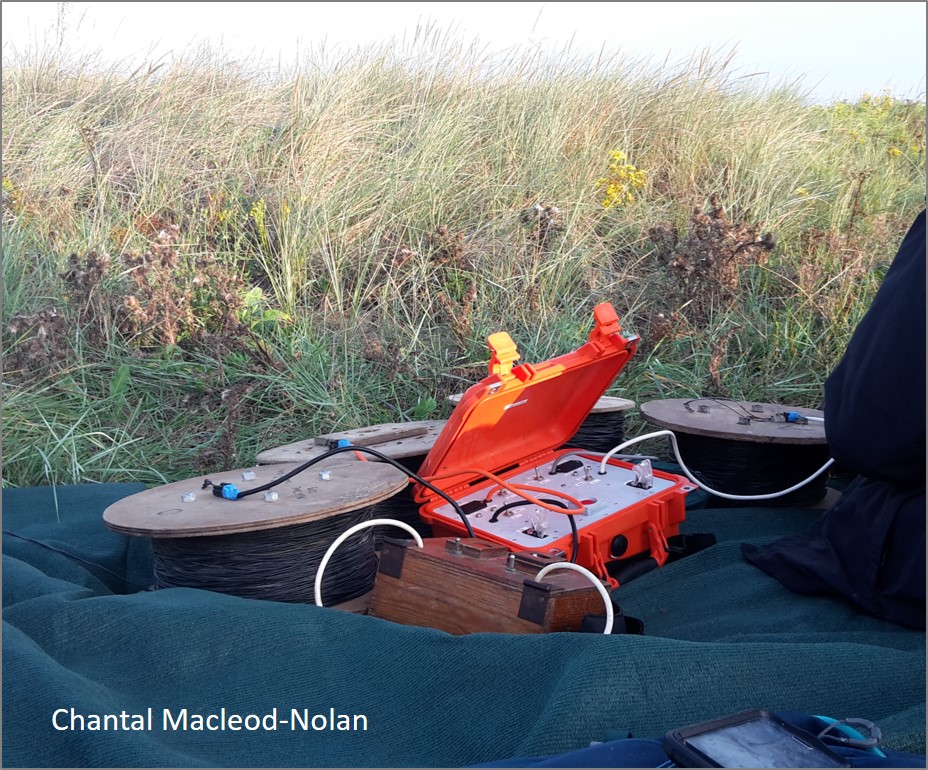

 The map alongside clearly demonstrates the strong link between the Wash and Norway. Other interesting things that have been discovered about Oystercatchers:
The map alongside clearly demonstrates the strong link between the Wash and Norway. Other interesting things that have been discovered about Oystercatchers: In the early days of the WWRG, Grey Plovers occurred in much smaller numbers than they do now. Writing in an article about the first 40 years of the Group, Clive Minton told the story of the first catch of 100, made in 1963, that was celebrated with three bottles of champagne provided by the late Hugh Boyd, delivering on an incentive that he had promised.
In the early days of the WWRG, Grey Plovers occurred in much smaller numbers than they do now. Writing in an article about the first 40 years of the Group, Clive Minton told the story of the first catch of 100, made in 1963, that was celebrated with three bottles of champagne provided by the late Hugh Boyd, delivering on an incentive that he had promised.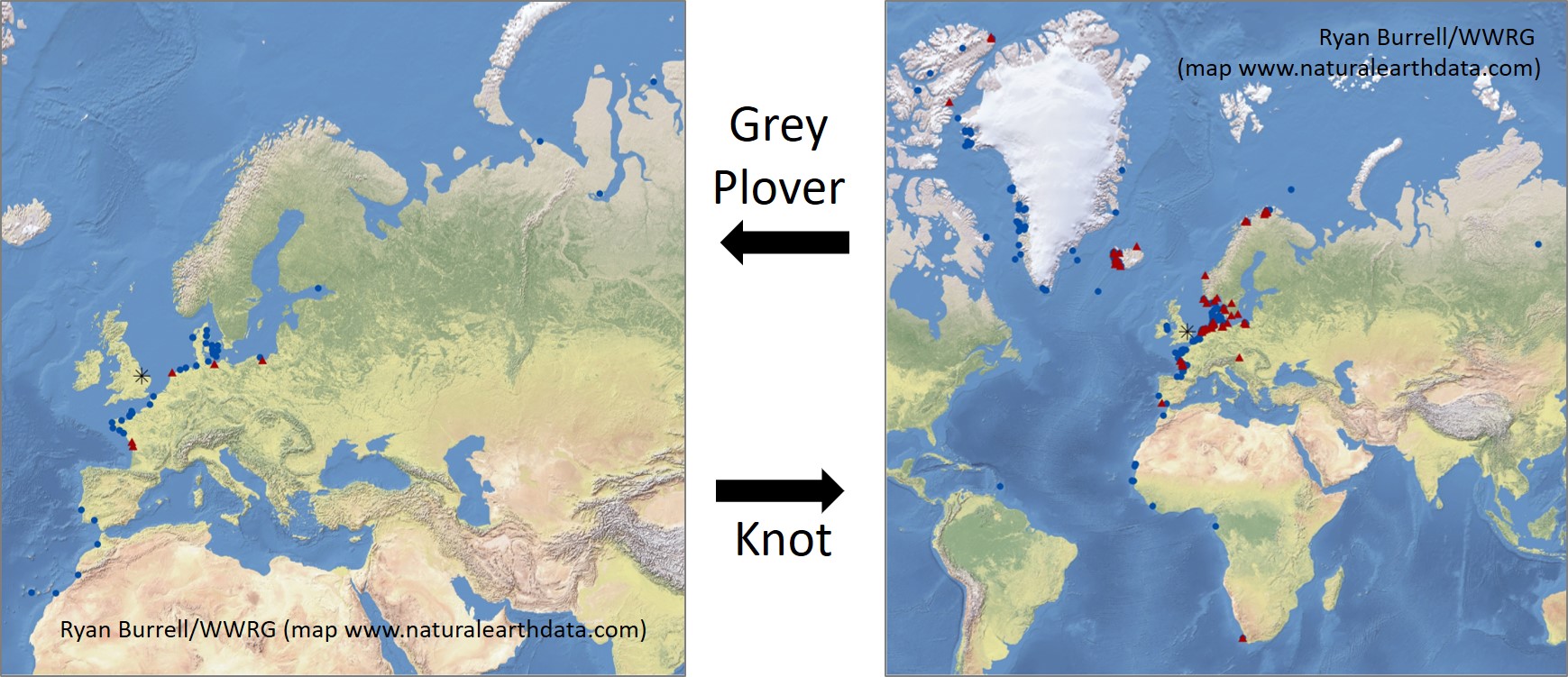
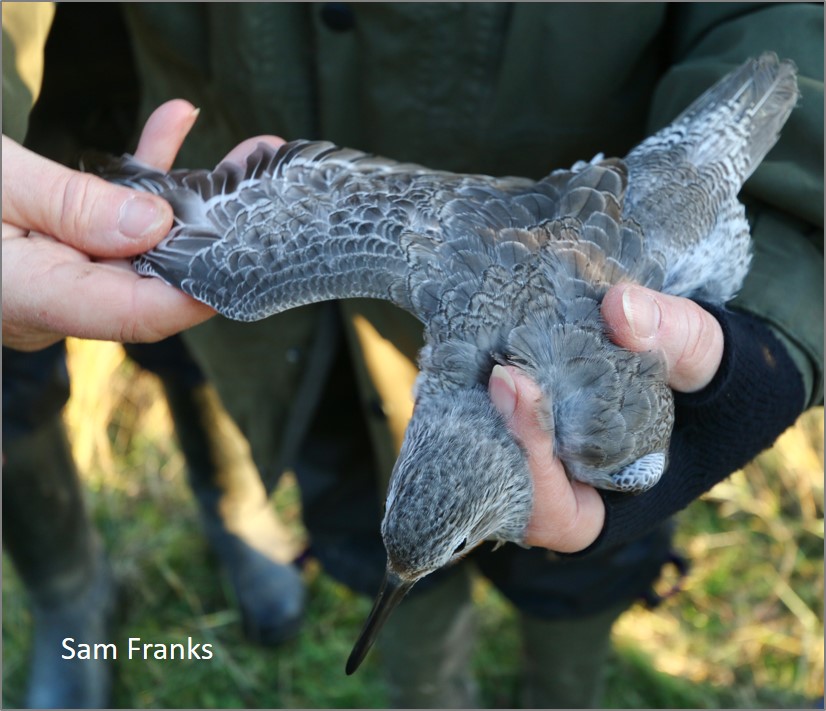

 The biggest catches of Sanderling are generally in the summer, when the Wash is a meeting point for birds from Greenland and Siberia. July can sometimes see catches of 200 or more birds. Traditionally, a Sanderling catch was the curtain-raiser at the start of Wash Week, an opportunity for the whole team to make one catch before splitting into ‘Terrington’ and ‘Lincolnshire’ teams for the rest of the main summer trip.
The biggest catches of Sanderling are generally in the summer, when the Wash is a meeting point for birds from Greenland and Siberia. July can sometimes see catches of 200 or more birds. Traditionally, a Sanderling catch was the curtain-raiser at the start of Wash Week, an opportunity for the whole team to make one catch before splitting into ‘Terrington’ and ‘Lincolnshire’ teams for the rest of the main summer trip.



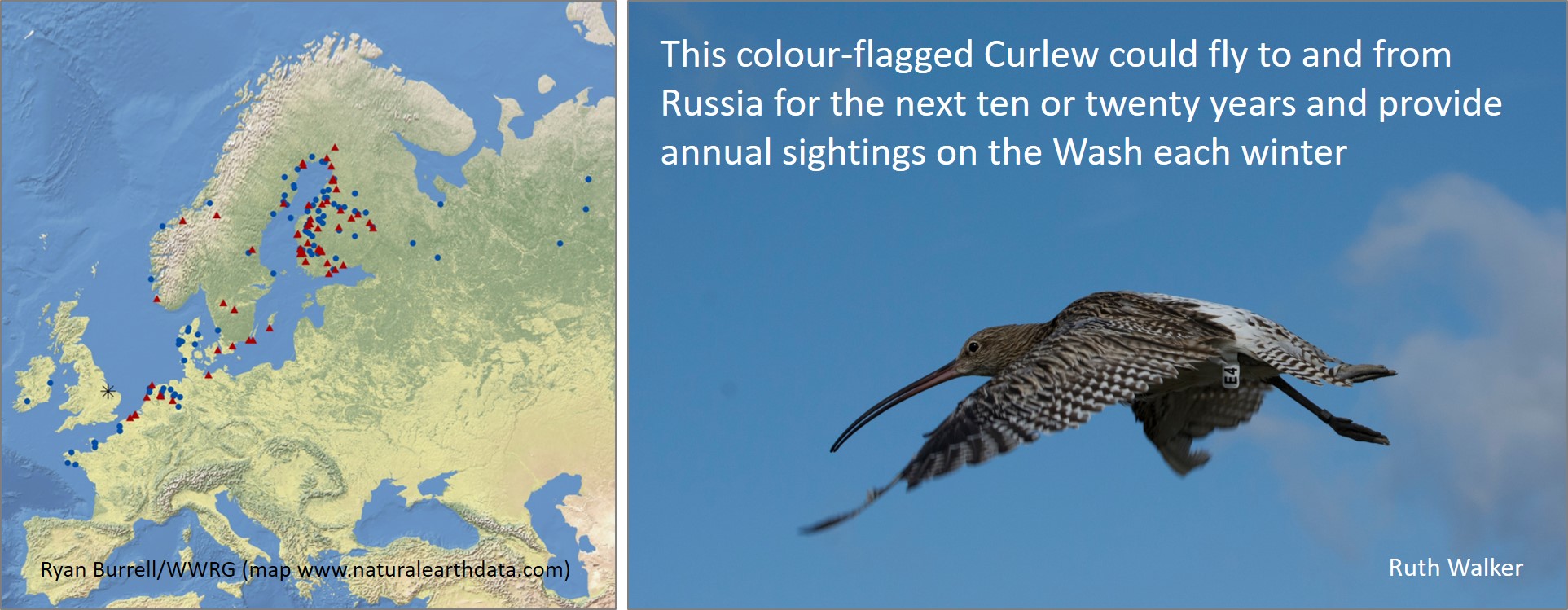
 The latest population estimates suggest that Great Britain has lost 26,000 wintering Redshank in less than a decade, representing a drop of 20%. Perhaps WWRG data can be used to help to explain these declines? Here are some of the things we know:
The latest population estimates suggest that Great Britain has lost 26,000 wintering Redshank in less than a decade, representing a drop of 20%. Perhaps WWRG data can be used to help to explain these declines? Here are some of the things we know:
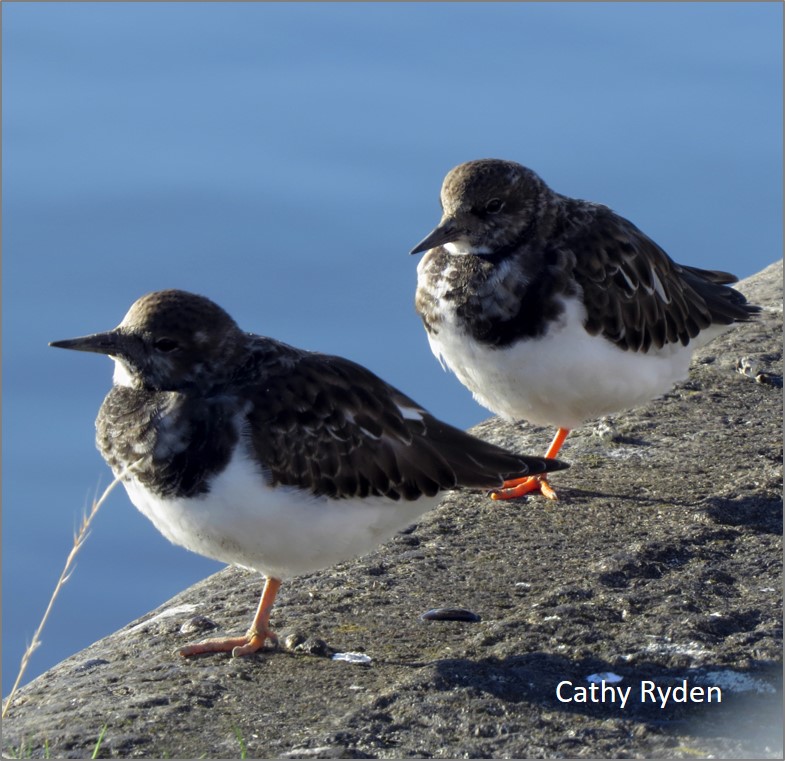 Winter Turnstone are birds that will head for Greenland and NE Canada in the spring but recoveries of birds in Finland and other Scandinavian countries indicate a passage of continental birds. African recoveries of WWRG-ringed birds probably include birds from Canada/Greenland and Finland/Scandinavia.
Winter Turnstone are birds that will head for Greenland and NE Canada in the spring but recoveries of birds in Finland and other Scandinavian countries indicate a passage of continental birds. African recoveries of WWRG-ringed birds probably include birds from Canada/Greenland and Finland/Scandinavia. Greenshank: The Group supports a colour-ringing project that was initiated by Pete Potts, in Hampshire.
Greenshank: The Group supports a colour-ringing project that was initiated by Pete Potts, in Hampshire. 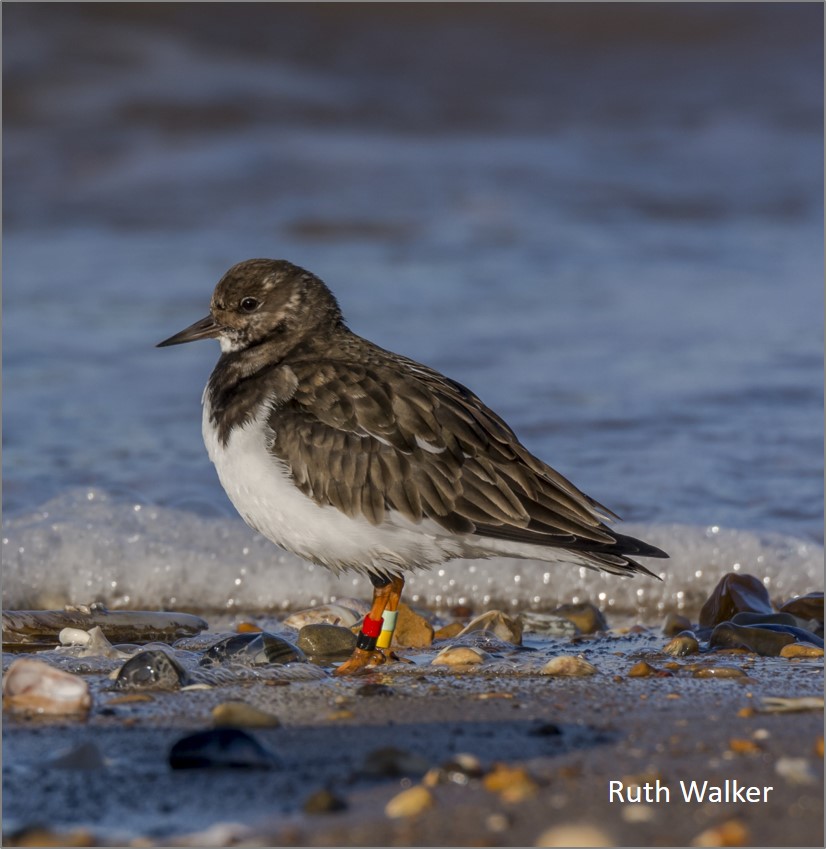 The Group still aims to maintain its general ringing programme, so that a representative sample of the key species carry rings.
The Group still aims to maintain its general ringing programme, so that a representative sample of the key species carry rings. 





 The table alongside gives an indication of the relative importance of Ireland, Great Britain and, together, the British Isles to the birds that use the East Atlantic flyway during the winter period. The three columns show the percentage of each species found in each of the three regions. Summarised international counts, as used in the paper, were kindly provided by Wetlands International. In the case of four species, Ireland is host to a significant proportion of the Icelandic breeding population (Oystercatcher, Golden Plover, Black-tailed Godwit and Redshank). There’s a WaderTales blog about the close link between
The table alongside gives an indication of the relative importance of Ireland, Great Britain and, together, the British Isles to the birds that use the East Atlantic flyway during the winter period. The three columns show the percentage of each species found in each of the three regions. Summarised international counts, as used in the paper, were kindly provided by Wetlands International. In the case of four species, Ireland is host to a significant proportion of the Icelandic breeding population (Oystercatcher, Golden Plover, Black-tailed Godwit and Redshank). There’s a WaderTales blog about the close link between 


 Most birdwatchers might associate flocks of waders with estuaries but Black-tailed Godwit is an excellent example of a species that also relies on inland fields, either close to estuaries or along river valleys. Whilst undertaking PhD research on Black-tailed Godwits in south-east Ireland, Daniel Hayhow showed that there is insufficient time to find enough estuarine food during the mid-winter tidal cycles, with birds topping up their resources on grassland. You can read more about the energetic consequences of choosing to winter in eastern England, Portugal and Ireland in this blog:
Most birdwatchers might associate flocks of waders with estuaries but Black-tailed Godwit is an excellent example of a species that also relies on inland fields, either close to estuaries or along river valleys. Whilst undertaking PhD research on Black-tailed Godwits in south-east Ireland, Daniel Hayhow showed that there is insufficient time to find enough estuarine food during the mid-winter tidal cycles, with birds topping up their resources on grassland. You can read more about the energetic consequences of choosing to winter in eastern England, Portugal and Ireland in this blog: 
 Paper
Paper
 Why is Scotland losing its breeding waders? This WaderTales blog is a story from Strathallan, based on observations by Mike Bell.
Why is Scotland losing its breeding waders? This WaderTales blog is a story from Strathallan, based on observations by Mike Bell.
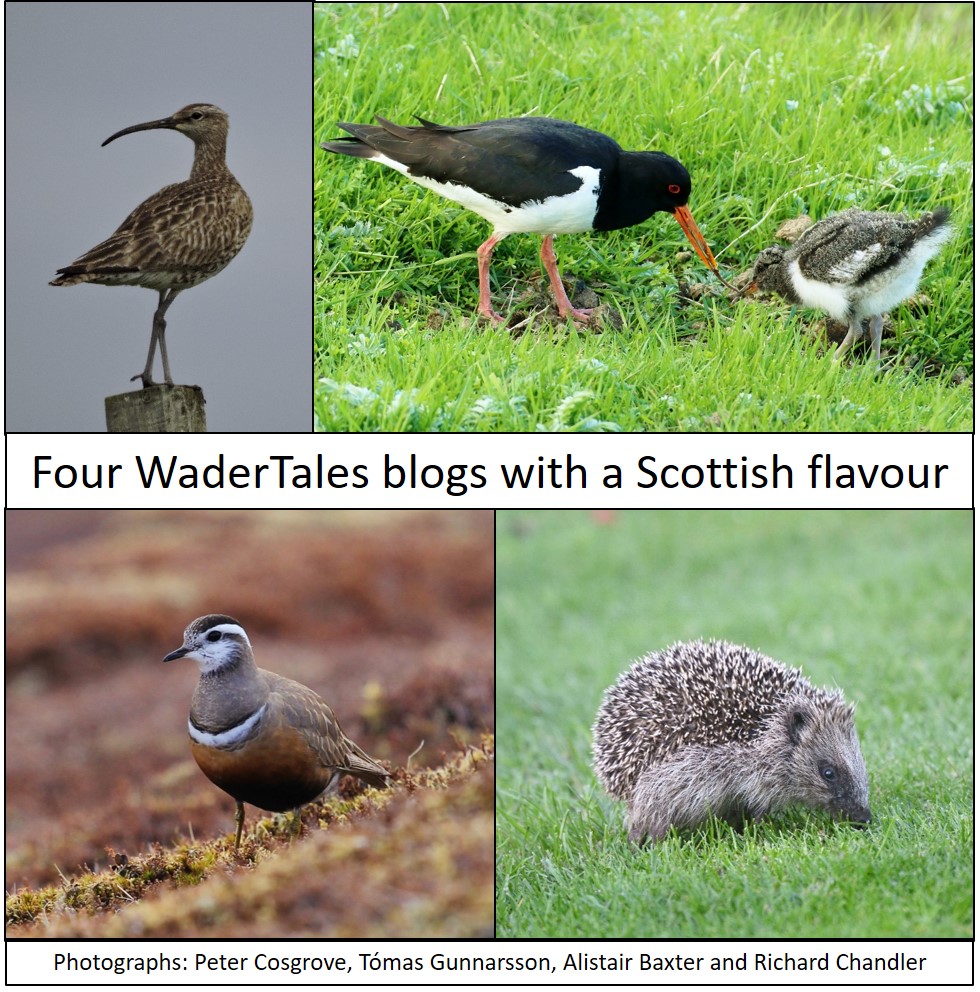 Establishing breeding requirements of Whimbrel
Establishing breeding requirements of Whimbrel 













 This year, we found far fewer waders than nine years ago. The table alongside provides a comparison for the three sections that we covered on Cumbrae for NEWS II and NEWS III. We failed to find any Purple Sandpipers in any of the 17 sections of the Clyde coast that we covered but were surprised to see a total of 5 Greenshanks. There seemed to be far fewer seabirds too. This is just a tiny snap-shot that may not be representative of the picture across the whole of the coastline of Britain & Ireland. Let’s hope that, despite the stormy weather, there was sufficient coverage for robust anlayses to be carried out by BTO staff.
This year, we found far fewer waders than nine years ago. The table alongside provides a comparison for the three sections that we covered on Cumbrae for NEWS II and NEWS III. We failed to find any Purple Sandpipers in any of the 17 sections of the Clyde coast that we covered but were surprised to see a total of 5 Greenshanks. There seemed to be far fewer seabirds too. This is just a tiny snap-shot that may not be representative of the picture across the whole of the coastline of Britain & Ireland. Let’s hope that, despite the stormy weather, there was sufficient coverage for robust anlayses to be carried out by BTO staff. We know that wader number on estuaries are changing. For instance, in the last few years, numbers of Ringed Plover in the UK have been falling (see figure). The declining line indicates a significant drop but it won’t be quite such a concern if this year’s NEWS-III surveyors find that there are now more Ringed Plovers on open coasts. That may seem like an optimistic suggestion, unless you look at changes between NEWS (1997/98) and NEWS-II (2006/07). During this period, at the same time that WeBS counts of estuaries were falling, there was actually a 25% increase in Ringed Plover numbers on open coast. Perhaps this redistribution from estuaries to open coasts has continued?
We know that wader number on estuaries are changing. For instance, in the last few years, numbers of Ringed Plover in the UK have been falling (see figure). The declining line indicates a significant drop but it won’t be quite such a concern if this year’s NEWS-III surveyors find that there are now more Ringed Plovers on open coasts. That may seem like an optimistic suggestion, unless you look at changes between NEWS (1997/98) and NEWS-II (2006/07). During this period, at the same time that WeBS counts of estuaries were falling, there was actually a 25% increase in Ringed Plover numbers on open coast. Perhaps this redistribution from estuaries to open coasts has continued?

 Colour-ringed Icelandic Oystercatchers are part of a new project to look at how climate change might be affecting migration patterns.
Colour-ringed Icelandic Oystercatchers are part of a new project to look at how climate change might be affecting migration patterns. 